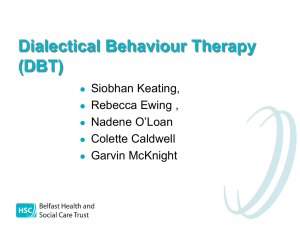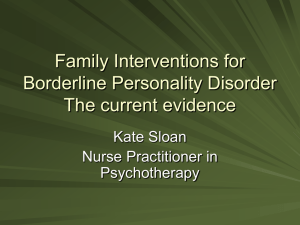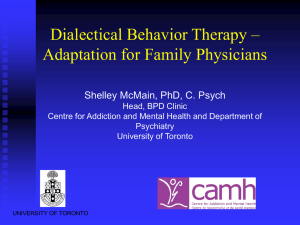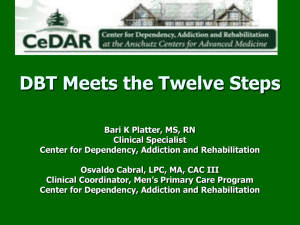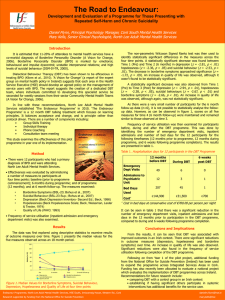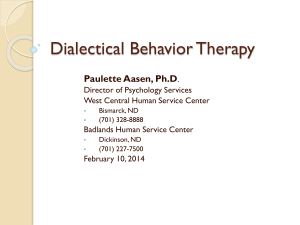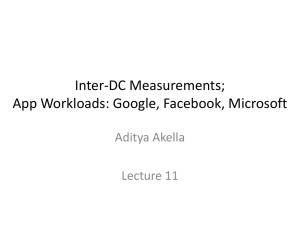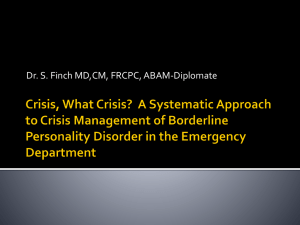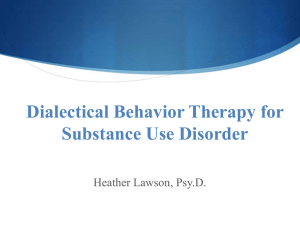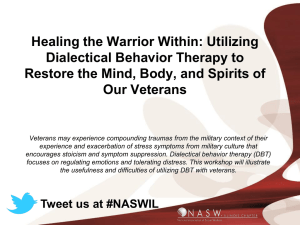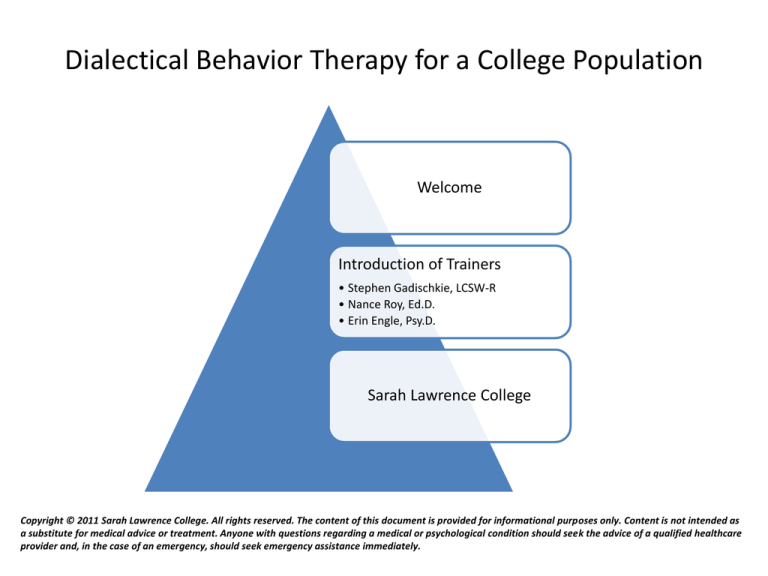
Dialectical Behavior Therapy for a College Population
Welcome
Introduction of Trainers
• Stephen Gadischkie, LCSW-R
• Nance Roy, Ed.D.
• Erin Engle, Psy.D.
Sarah Lawrence College
Copyright © 2011 Sarah Lawrence College. All rights reserved. The content of this document is provided for informational purposes only. Content is not intended as
a substitute for medical advice or treatment. Anyone with questions regarding a medical or psychological condition should seek the advice of a qualified healthcare
provider and, in the case of an emergency, should seek emergency assistance immediately.
Goals of Mindfulness Practice
Reduce
Suffering
• Reduce Pain & Suffering
• Decrease Tension & Stress
• Regulate Emotional Response
Increase
Happiness
• Increase Joy & Happiness
• Improve Physical Health
• Improve Relationships
• Increase Distress Tolerance
Experience
Reality As
It Is
• Be Present To Your Life
• Be Present in the Lives of Those You Love
• Experience the Reality of:
• Connection
• Essential “Goodness”
• Essential Validity
Adapted from: Behavior Therapy Skills Training Manual for Borderline Personality Disorder, by Marsha Linehan© 2009 New York, Guilford Press
Agenda
Program
BPD
DBT
Results
History
During Fall Semester 2004 – 16 Individual Psychiatric Hospitalizations
Many of these
students had
histories of multiple
non-fatal suicidal
behaviors:
Suicide attempts,
suicidal thoughts,
urges to suicide
Intentional self-harm
behaviors:
overdoses, selfstabbings, burns
Mental health
services required:
New Therapist
Strategies
New Client Targets
Other problems:
Depression, Anxiety,
Bipolar Disorder,
PTSD, ED, AOD
abuse
2005 SLC Health Services sent 4 clinicians to the
New York DBT Intensive Training Course
What is BPD?
Emotional
Dysregulation
• Emotional vulnerability
• Quick, intense, difficult to control
• Invalidating environment
• Inability to modulate emotions
Behavior
Dysregulation
Interpersonal
Dysregulation
Self
Dysregulation
Cognitive
Dysregulation
• Suicidal Behavior
• Deliberate self-injury
• Impulsive behavior
• Chaotic relationships
• Fears of abandonment
• Identity disturbance
• Confused sense of self
• Sense of emptiness
• Dissociative responses
• Paranoid ideation
BPD is a Pervasive Disorder of the Emotion Regulation System.
BPD criterion behaviors function to regulate emotions or are a
natural consequence of emotion dysregulation.
Adapted from: Linehan Ph.D., Marsha M., Cognitive Behavioral Treatment of Borderline Personality Disorder, 1993, New York, Guilford Press
BPD Can Be Fatal
BPD is associated with fatal and non-fatal suicidal behaviors
Among suicides, 40-65% have a personality disorder
Among personality disorders, BPD is most associated with suicidal behavior
Among BPD, 8-10% commit suicide
Up to 75% attempt suicide
Between 69-80% self-mutilate
2002-2010 Marsha M. Linehan, Ph.D. Five Day Foundation DBT Training Course
What is DBT?
Fundamentals
• Cognitive-Behavioral Therapy
• Mindfulness Based Treatment
• Synthesis of Change and
Acceptance
• Therapist-Student Relationship
• Weekly Individual Therapy
• Weekly Group Skills Training
• Access to 24-Hour Telephone
Coaching
• Weekly Consultation Team
• Empirically-Supported
Treatment
Outcomes
Reduces:
• Suicidal behaviors
• Intentional self-injury
• Depression
• Hopelessness
• Anger
• Eating disorders
• Substance dependence
• Impulsiveness
Increases:
• Adjustment (general & social)
• Positive self-esteem
2002-2010 Marsha M. Linehan, Ph.D. Five Day Foundation
DBT Training Course
BPD Core Problem Areas
and DBT Skills Training Modules
Confusion
About Self
“I’m not sure who I
am or what I want
in life”
Mindfulness
Impulsivity
“I usually act
quickly, without
thinking”
Distress
Tolerance
Emotional
Dysregulation
“Once I get upset,
it takes me a long
time to calm
down”
Emotion
Regulation
Interpersonal
Chaos
“Many of my
relationships have
been full of intense
arguments”
Interpersonal
Effectiveness
A Community Treating a Community of Students
Proactive Identification of Multi-Diagnostic Student Population
Collaborate with Faculty/Staff/Students
Identifying Students/Referrals to Health Service
Self-Referral (walk-in, consultation, intake)
Faculty and Staff Referrals
Students returning from a Leave with Review (LWR)
Collaboration Between Primary Care and Counseling (Utilize
PHQ-9 Scores)
Following a Psychiatric Hospitalization
Mandated AOD Assessment (Student Affairs)
Disruption in Dormitories (Residential Life)
Reduced Course Load (Dean of Studies)
Peer Referral
Referrals are made to Health Services Primary Care, Nutritionists, AOD Treatment
Modification to DBT for a College Population
Student
• Students stay in therapy for a
minimum of one academic
semester
• Skills training
• 60 minute groups/ weekly
• Teaching fewer skills
• Graduate process group
• Life skills group
• Skills only component
• Maintain confidentiality
• What is said in the group,
stays in the group
• Home therapists during break
Therapist
• Coaching - access to 24-hour
telephone support (limited to
semester)
• Standard DBT Handouts, adapting
the examples relevant for college
• Weekly consultation team (limited
to semester)
• Confidentiality and limitations
• Provide student’s with a list of
home referrals (between
semesters)
Adapted Skills Training Treatment Cycle
Mindfulness
(4 weeks)
Distress
Tolerance
(6 weeks)
Emotion
Regulation
(6 weeks)
Mindfulness
Review
(2 weeks)
Mindfulness
Review
(2 weeks)
Interpersonal
Effectiveness
(6 weeks)
Adapted from: Behavior Therapy Skills Training Manual for Borderline Personality Disorder, by Marsha Linehan© 2009 New York, Guilford Press
Summary of Initial Findings for DBT Students
Diary Cards
• Less likely to engage in intentional
self-injury at all during treatment
Primary Care
• No medically severe intentional selfinjury
• Less medical appointments for
somatic illness
Symptom Checklist-90
• Overall level and severity of
psychological symptoms decreased
Suicidal Ideation Questionnaire-JR
Decrease in suicidal ideation (90%):
• Suicidal ideation
• Level of distress
• Suicidal intent
Reasons for Living Scale reflected:
• “Survival and Coping Beliefs” and
“Responsibility to Family” seem
most salient
Life Problems Inventory
Following the Mindfulness module
overall improvement:
• Acceptance of self (67%)
• General emotional control (67%)
• Interpersonal effectiveness (78%)
• Distress tolerance (67%)
Patient Health Questionnaire
From baseline testing students overall
maintained/improved:
• Reduced depression (70%)
• Decreased suicidal ideation (80%)
• Academic performance (80%)
Is the Treatment Effective?
Psychiatric Hospitalizations
BPD Dx Population
Fall '10
Total
Percent
42
Spring '10
Total
Percent
41
Fall '09
Total
Percent
37
Spring '09
Total
Percent
30
BPD with DBT
Psych Hospitalizations
12
0
28.6%
0.0%
10
0
24.4%
0.0%
9
0
24.3%
0.0%
9
0
30.0%
0.0%
BPD non-DBT (TAU)
Psych Hospitalizations
30
2
71.4%
6.7%
31
5
75.6%
16.1%
28
1
75.7%
3.6%
21
1
70.0%
4.8%
• Individual treatment coupled with skills training has eliminated
Psych Hospitalizations for the last 4 semesters vs 9 hospitalizations
(8%) non-DBT
• Highly suicidal people do not have the skills to regulate their
behavior and emotions – you have to teach those skills
• Phone coaching provides a bridge, helping to apply skills during crisis
Is the Treatment Effective?
AOD Hospitalizations
BPD Dx Population
Fall '10
Total
Percent
42
Spring '10
Total
Percent
41
Fall '09
Total
Percent
37
Spring '09
Total
Percent
30
BPD with DBT
AOD Hospitalizations
12
0
28.6%
0.0%
10
0
24.4%
0.0%
9
0
24.3%
0.0%
9
0
30.0%
0.0%
BPD non-DBT (TAU)
AOD Hospitalizations
30
0
71.4%
0.0%
31
2
75.6%
6.5%
28
1
75.7%
3.6%
21
1
70.0%
4.8%
• Targets related to life-threatening, therapy interfering, and quality of
life are discussed and maintained – assisting to eliminate AOD
Hospitalizations 0% in the last 4 semesters with the DBT population vs.
4 (3.5%) in the Non-DBT population
• Mindfulness is developing a lifestyle of participating with awareness.
An assumption in DBT is that participation without awareness is a
characteristic of impulsive and mood dependent behaviors.
Is the Treatment Effective?
Leaves with Review
BPD Dx Population
Fall '10
Total
Percent
42
Spring '10
Total
Percent
41
Fall '09
Total
Percent
37
Spring '09
Total
Percent
30
BPD with DBT
Leaves with Review
12
0
28.6%
0.0%
10
0
24.4%
0.0%
9
1
24.3%
11.1%
9
0
30.0%
0.0%
BPD non-DBT (TAU)
Leaves with Review
30
5
71.4%
16.7%
31
2
75.6%
6.5%
28
1
75.7%
3.6%
21
5
70.0%
23.8%
• Of the 40 students that have entered DBT skills since Fall of ’09:
1 (2.5%) has LWR vs. 13 (12%) non-DBT
• DBT is effective when it is a combination of individual therapy
and skills training
• DBT is the gold standard in comprehensive treatment for multiproblem individuals
Q&A
Appendix
Assessment Instruments
Diagnosing BPD
Life Problems Inventory (LPI)
• Clinical Interview using the DSM-IV
diagnostic criteria for BPD. Present
or past history of deliberate selfharm behaviors and at least 4 of the
other 8 diagnostic criteria:
Intense/unstable relationships; fears
of abandonment; identity
disturbance; sense of emptiness;
suicidal behaviors; affective
instability; problems with anger; and
paranoid/dissociative symptoms.
• The LPI (60 items) is a self-report
questionnaire that measures BPD
core problem areas and DBT skills
training modules. The measure has
four subscales: Confusion about self
(Mindfulness); Impulsivity (Distress
Tolerance), Emotion Dysregulation
(Emotion Regulation), and
Interpersonal Chaos (Interpersonal
Effectiveness).
Assessment Instruments
Suicidal Ideation Questionnaire (SIQ-JR)
Reasons for Living Scale (RFL)
• The SIQ-JR (15 items) is a self-report
questionnaire that assesses the frequency
of suicidal ideation, level of distress, and
suicidal intent in adolescents.
• The RFL (48 items) is a self-report
questionnaire that measures clients'
expectancies about the consequences of
living versus killing oneself and assesses
the importance of various reasons for
living. The measure has six subscales:
Survival and Coping Beliefs, Responsibility
to Family, Child-Related Concerns, Fear of
Suicide, Fear of Social Disapproval, and
Moral Objections.
Assessment Instruments
Symptom Checklist
90-Revised
Alcohol Use Disorders Identification
Test
(SCL-90-R)
(AUDIT-C)
• The SCL-90-R (90 items) is a self-report
questionnaire used to evaluate a broad
range of psychological problems and
symptoms of psychopathology. The
instrument is also useful in measuring
client progress. The instrument has
nine symptom Scales: Somatization,
Obsessive-Compulsive, Interpersonal
Sensitivity, Depression, Anxiety,
Hostility, Phobic Anxiety, Paranoid
Ideation, and Psychoticism.
• The AUDIT-C (3 items) is a self-report
screen that can help identify students
who use alcohol hazardously. There are
two components of the AUDIT-C:
Assessing alcohol use (including
frequency of drinking, typical quantity
and frequency of heavy drinking) and
deriving an impairment score to help
select and monitor treatment.
Assessment Instruments
Patient Health
Questionnaire (PHQ-9)
Mental Health Continuum
(MHC-SF)
Lucas Functional
Assessment
• The PHQ-9 (9 items) is a
self-report scale for
diagnosing depression as
well as selecting and
monitoring treatment.
There are two
components of the PHQ9: Assessing symptoms
and functional
impairment to make a
depression diagnosis, and
deriving a severity score
to help select and
monitor treatment.
• The MHC (short form - 14
items) is a self-report
questionnaire that
measures students‘
functioning as
“Languishing”,
“moderately mentally
healthy” or “flourishing
level”. The measure has
three “Well-Being”
Clusters: Emotional,
Social, and Psychological.
• The LFA (6 items) is a selfreport questionnaire that
measures students'
functional level. The
measure has three
subscales: Academic,
Friendships, and Social
Connectedness.
Diary Card
DBT Diary Card - SLC
Name
Week of
Today I felt this emotional intensity :
0 = no intensity
5 = most intense
Day
Mon
Tues
Wed
Thurs
Fri
Sat
Sun
SKILLS
Mindfulness
Emotion
Regulation
Interpersonal
Effectiveness
Distress
Tolerance
Sad Mad
Glad
Bad Anxious
Self
Conscious
Lonely
RSkill Worked TTried skill, didn't work *Could have tried the skill
Wise Mind (balance emotion & reason)
Observe (pause, just notice, teflon mind)
Describe (what am I feeling, pause and ask)
Participate (enter into the experience)
Non-Judgmental (just the facts)
One Mindful (fully participate)
Effective (focus on what works vs being right)
Opposite-to-Emotions Action
Ride the Wave (feelings rise & fall - ride them out)
ABC (Accumulate positives, Build mastery, Cope ahead)
PLEASE (Physical ills, Eating, Avoid drugs, Sleep-exercise)
Grounding (deep breathing-feel feet on floor-name objects)
DEAR (Describe, Express, Assert, Reiforce)
MAN - Mindful (broken record, ignore attacks)
MAN (appear confident, negotiate, turn the tables)
GIVE (Gentle, Interested, Validate, Easy manner)
FAST (Fair, no Apologies, Stick to values, Truthful
Pros and Cons
Distract - Self sooth, Improve the moment
Radical Acceptance
Willingness, Half-Smiling - Mindfulness of current thoughts
Empty
Restrict/
Purge
Mon
Tues
Today I have an urge to :
0 = no intensity
5 = most intense
circle # if acted on urge
Drug
Self
Drink Isolate Lie Obsess Injure
Wed
Thurs
Fri
Sat
Sun
Suicide
Total

